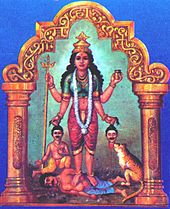- Mohini
-
This article is about an avatar of the Hindu God Vishnu. For other uses, see Mohini (disambiguation).
Mohini 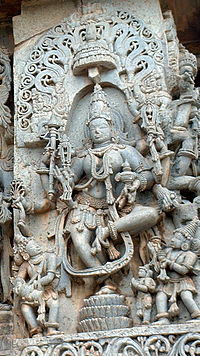
A sculpture of an eight-armed dancing Mohini at the Hoysaleswara Temple in Halebidu.Devanagari मोहिनी Sanskrit Transliteration Mohinī Affiliation Avatar of Vishnu Weapon Mohini-astra (seduction), Sudarshana Chakra Consort Shiva Mohini (Sanskrit: मोहिनी, Mohinī), in Hindu mythology, is the name of the only female Avatar of the god Vishnu. She is portrayed as a femme fatale, an enchantress, who maddens lovers, sometimes leading them to their doom. Mohini is introduced into the Hindu mythos in the narrative epic of the Mahabharata. Here, she appears as a form of Vishnu, acquires the pot of Amrita (an elixir of immortality) from thieving asuras (demons), and gives it back to the Devas (demi-gods), helping them retain their immortality.
Many different legends tell of her various exploits and marriages, including union with Shiva. These tales relate, among other things, the birth of the god Shasta and the destruction of Bhasmasura, the ash-demon. Mohini’s main modus operandi is to trick or beguile those she encounters. She is worshipped throughout Indian culture, but mainly in Western India, where temples are devoted to her depicted as Mahalasa, the consort of Khandoba, a regional avatar of Shiva.
Contents
Etymology
The name Mohini comes from the verb root moha, meaning "to enchant, perplex, or disillusion,"[1][2] and literally means "delusion personified." In the Baiga culture of Central India, the word mohini means "erotic magic or spell."[3] The name also has an implied connotation of "the essence of female beauty and allurement."[4]
Legends and history
The Amrita
The earliest reference to a Mohini-type goddess appears in the Samudra manthan episode of the 5th century BCE Hindu epic Mahabharata.[5] The Amrita, or nectar of immortality, is produced by the churning of the Ocean of Milk. The Devas (demi-gods) and the Asuras (demons) fight over its possession.[6] The Asuras contrive to keep the Amrita for themselves, angering the Devas. Vishnu, wise to their plan, assumes the form of an "enchanting damsel". She uses her allure to trick the Asuras into giving her the Amrita, and then distributes it amongst the Devas. Rahu, an Asura, disguises himself as a god and tries to drink some Amrita himself. Surya (the sun-god) and Chandra (the moon-god) quickly inform Vishnu, and he uses the Sudarshana Chakra (the divine discus) to decapitate Rahu, leaving head immortal.[7] The decapitated body becomes Ketu. Rahu and Ketu are both regarded as celestial bodies that assume one's destiny. The other major Hindu epic Ramayana (4 century BCE) narrates the Mohini story briefly in the Bala Kanda chapter.[8] This same tale is also recounted in the Vishnu Purana four centuries later.[9]
In the original text, Mohini is referred to as simply an enchanting, female form of Vishnu. In later versions, Mohini is described as the maya (illusion) of Vishnu. Later still, the name of the avatar becomes Mohini from the original phrase describing his deliberate false appearance (mayam ashito mohinim).[10] Once the Mohini legend became popular, it was retold, revised, and expanded in several texts. The tales of Mohini-Vishnu also increased among devotional circles in various regions.[11][12] The same expanded Mahabharata version of the story is also recounted in the Bhagavata Purana in the 10th century CE.[13][14][15] Here, Mohini becomes a formal avatar of Vishnu.[16]
This legend is also retold in the Padma Purana[16] and Brahmanda Purana. In the Brahmanda Purana, however, Vishnu-Mohini simply, after mediation upon the Great Goddess Maheshvari, acquires her form to trick the thieving asuras.[12]
Slayer of demons
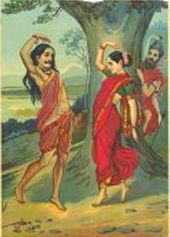 Bhasmasura-Mohini by Raja Ravi Varma. Bhasmasura (left) is about to place his hand on his head following the dancing Mohini (centre), as Shiva (right) looks from behind the tree.
Bhasmasura-Mohini by Raja Ravi Varma. Bhasmasura (left) is about to place his hand on his head following the dancing Mohini (centre), as Shiva (right) looks from behind the tree.
Mohini also has an active history in the destruction of demons throughout Hindu texts. In the Vishnu Purana, Mohini defeats Bhasmasura, the "ash-demon".[17] Bhasmasura invokes the god Shiva by performing severe penances. Shiva, pleased with Bhasmasura, grants him the power to turn anyone into ashes by touching their head. The demon decides to try the power on Shiva himself. Shiva runs terrified. Vishnu, witnessing the unfortunate turn of events, transforms into Mohini and charms Bhasmasura. Bhasmasura is so taken by Mohini that he asks her to marry him. Mohini agrees, but only on the condition that Bhasmasura follows her move for move in a dance. In the course of the dance, she places her hand on her head. Bhasmasura mimics the action, and in turn, reduces himself to ashes.[18] The legend of Bhasmasura is retold in the Buddhist text Satara Dewala Devi Puvata, with a slight variation. In this tale, Vishnu assumes his female form (the name "Mohini" is not used) and charms Bhasmasura. The female Vishnu asks Bhasmasura to promise never to leave her by taking his hand on his head as per the usual practice to swear on one's head. On doing so, Bhasmasura is reduced to ashes.[19]
In an similar legend related to birth of Ayyappa, the demon Surpanaka earns the power to turn anyone into ashes by his austerities. The tale mirrors all other aspects of the Buddhist version of the Bhasmasura tale, where he is forced by Mohini to severe fidelity by keeping his hand on his head and is burnt.[20]
The prelude of the Ramakien, the Thai version of the Ramayana, the demon Nontok is charmed and killed by Mohini-Vishnu. Nontok misuses a divine weapon given to him by Shiva. The four-armed Mohini-Vishnu enchants Nontok and then attacks him. In his last moments, the demon accuses Vishnu of foul play saying that Vishnu first seduced him and then attacked him. Vishnu decrees that in his next birth, Nontok will be born as the ten-armed demon Ravana and Vishnu will be a mortal man called Rama. He will then fight him and defeat him.[21]
In a lesser-known tale in the Ganesha Purana (900—1400CE) the wise asura king Virochana is rewarded a magical crown by the sun-god Surya. The crown shields him against all harm. Vishnu as Mohini then enchants Virochana and steals his crown. The demon, thus unprotected, is killed by Vishnu.[22]
Another legend about the demon Araka associates Mohini with Krishna (yet another Avatar of Vishnu) rather than the god himself. The demon Araka had become virtually invincible because he had never laid eyes on a woman (extreme chastity). Krishna takes the form of the beautiful Mohini and marries him. After three days of marriage, Araka's bonds of chastity are broken, and Krishna kills him in battle.[23] Transgender Hijras consider Krishna-Mohini as a transsexual, rather than a true female.[24]
Relationship with Shiva
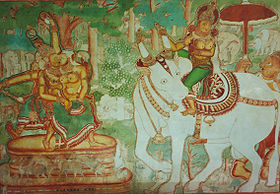 A Mattancherry palace mural shows Shiva and Mohini in an embrace while Parvati seated on the white bull, looks at them and smirks.[25]
A Mattancherry palace mural shows Shiva and Mohini in an embrace while Parvati seated on the white bull, looks at them and smirks.[25]
In the Bhagavata Purana, after Vishnu deceives the demons by his maya female form, Shiva wishes to see the bewildering Mohini again. When Vishnu agrees and reveals his Mohini form, Shiva runs crazily behind Mohini, "bereft of shame and robbed by her of good sense," while the abandoned wife Parvati (Uma) looks on. Shiva is overcome by Kāma (lust or Kamadeva, the god of lust). His "unfailing" seed escapes like that of "a love-maddened elephant chasing a desiring female" and falls on ground creating ores of silver and gold. Afterwards, Vishnu comes to his true form and reveals that his maya (illusory power) can not be surpassed even by Shiva. Shiva then extols Vishnu's power.[13][26]
The Tripurarahasya, a south Indian Shakta text, retells the story, giving more importance to the Goddess. When Shiva wishes to see Vishnu's Mohini form again, Vishnu fears that he may be burned to ashes like Kamadeva by the ascetic Shiva. So, Vishnu prays to goddess Tripura, who grants half of her beauty to Vishnu, begetting the Mohini-form. As Shiva touches Mohini, his seed spills, indicating a loss of the merit gained through of all his austerities.[27]
In the Brahmanda Purana when the wandering sage Narada tells Shiva about Vishnu's Mohini form that deluded the demons, Shiva dismisses him. Shiva and his wife Parvati go to Vishnu's home. Shiva asks him to take on the Mohini form again so he can see the actual transformation for himself. Vishnu smiles, again mediates on the Goddess, and in place of Vishnu stands the gorgeous Mohini. Overcome by lust, Shiva chases Mohini as Parvati hangs her head in shame and envy. Shiva grabs Mohini's hand and embraces her, but Mohini frees herself and runs further. Finally, Shiva grabs her and their "violent coupling" leads to discharge of Shiva's seed which falls "short of its goal," suggesting the act was consummated. The seed falls on the ground and the god Maha-Shasta ("The Great Chastiser") is born. Mohini disappears, while Shiva returns home with Parvati.[28][29] Shasta is identified primarily with two regional deities: Ayyappa from Kerala and the Tamil Aiyanar. He is also identified with the classical Hindu gods Skanda and Hanuman.[30] In the later story of the origin of Ayyappa, Shiva impregnates Mohini, who gives birth to Ayyappa. They abandon Ayyappa in shame. The legend highlights Vishnu's protests to be Mohini again and also notes that Ayyappa is born of Vishnu's thigh as Mohini does not have a real womb.[31] Another variant says that instead of a biological origin, Ayyappa sprang from Shiva's semen, which he ejaculated upon embracing Mohini.[32] Ayyappa is referred to as Hariharaputra, "the son of Vishnu (Hari) and Shiva (Hara)", and grows up to be a great hero.[33]
In the Agni Purana, as the enchanted Shiva follows Mohini, drops of his semen fall on the ground and become lingas, Shiva's symbols. His semen also generates the monkey-god Hanuman, who helps Vishnu's avatar Rama in his fight against Ravana in the Ramayana.[34] The Shiva Purana says that by the mere glimpse of Mohini, Shiva spurts out his seed. The seed was collected and poured into the ear of Anjani, who gave birth to Hanuman, an incarnation of Shiva.[35] The latter is retold in the Thai and Malaysian version of the Ramayana.[36] Though Hanuman springs from Shiva's seed, he is also considered as a combined son of Vishnu and Shiva.[17]
The Buddhist version of the Bhasmasura tale continues with Shiva (Ishvara) asking the female-Vishnu, who is seated on a swing, to marry him. She asks Shiva to get the permission of his wife Umayangana to take her home. Shiva returns with Umayangana's consent to find the female-Vishnu pregnant, who sends him back to get permission to bring a pregnant woman home. When he returns, a child is born and female-Vishnu is pregnant again. She requests Shiva to seek approval to bring a pregnant woman with a child home. This happens six more times. Finally, Shiva brings Umayangana with him to witness the miraculous woman. Vishnu then returns to his male form. Umayangana embraces the six youngest children merging them into the six-headed Skanda, while the eldest, named Aiyanayaka ("eldest brother") remains intact.[19] Aiyanayaka is identified with Aiyanar.
The rare instance where an "explicit, male homosexual act" is suggested is in a Telugu text where when Shiva is busy lovemaking with Mohini-Vishnu, the latter returns to his original form and still the lovemaking continues.[24]
Mohini plays a lesser role in a Shaiva legend in the Skanda Purana. Here, Vishnu as Mohini joins Shiva to teach a lesson to arrogant sages. A group of sages are performing rituals in a forest, and start to consider themselves as gods. To humble them, Shiva takes the form of an attractive young beggar (Bhikshatana) and Vishnu becomes Mohini, his wife. While the sages fall for Mohini, their women wildly chase Shiva. When they regain their senses, they perform a black magic sacrifice, which produces a serpent, a lion, a elephant (or tiger) and a dwarf, all of which are overpowered by Shiva. Shiva then dances on the dwarf and takes the form of Nataraja, the cosmic dancer.[37] The legend is retold in the Tamil Kovil Puranam and Kandha Puranam with some variation.[27][35][38] This legend is also told in the Sthala Purana related to the Chidambaram Temple dedicated to Shiva-Nataraja.[39]
Another legend from the Linga Purana says that the embracing of love-struck Shiva and Mohini led to be their merging into one body. At this moment, Mohini became Vishnu again, resulting the composite deity Harihara, whose right side of the body is Shiva and left side is Vishnu in his male form.[40][41] In the temple in Sankarnayinarkovil near Kalugumalai is one of the rarest exceptions to iconography of Harihara (Sankara-Narayana). The deity is depicted similar to the Ardhanari, the composite form of Shiva-Parvati, where right side of the body is the male Shiva and left side is female. This image's female side represents Mohini and it, as a whole, symbolizes the union of Shiva and Mohini.[42] In a Harihara image, the Shiva side has an erect phallus (urdhva linga) and relates to Shiva's love to his left side Vishnu-Mohini.[43] The influence of Shakta traditions on Shaiva ones may have led to the development of composite images like Harihara, where Vishnu is identified with Shiva's consort, or Mohini.[44] Like the Kanda Puranam narrative, the Shaiva saint Appar identifies Vishnu as Parvati (Uma), the female counterpart of Shiva.[45]
Other legends
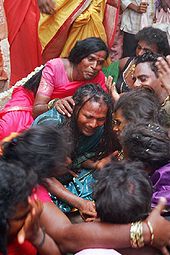 Aravanis, the transgender "brides" of god Aravan, mourn his death. Aravanis don the role of Mohini-Krishna.
Aravanis, the transgender "brides" of god Aravan, mourn his death. Aravanis don the role of Mohini-Krishna.
In the Brahma Vaivarta Purana, Mohini tries to seduce the creator-god Brahma. While doing so, she says, "A man who refuses to make love to a woman tortured by desire is a eunuch. Whether a man is ascetic or amorous, he must not spurn a woman who approaches him, or he will go to Hell. Come now and make love to me." In one breath, Brahma replies, "Go away, Mother". He argues that he is like her father, and thus, too old for Mohini. Mohini then reminds him that he had already committed incest with his daughter.[46]
Another folktale tells of the Mahabharata hero Aravan (who becomes the Tamil god Kuttantavar), who was married to Mohini, before his self-sacrifice. Aravan agrees to become the sacrificial victim for the Kalappali ("sacrifice to the battlefield") to ensure the victory of the Pandavas, his father, and his uncles. Before being sacrificed to goddess Kali, Aravan asks three boons from Krishna, the guide of the Pandavas. The third boon was that Aravan should be married before the sacrifice so that he could get the right of cremation and funerary offerings (bachelors were buried). This third boon, however, is found only in the folk cults. To fulfill this wish in the Kuttantavar cult myth, Krishna turns into Mohini, marries Aravan, and spends the night with him. Then after the sacrifice, Mohini laments Aravan's death, breaking her bangles, beating her breasts, and discarding her bridal finery. She then returns to the original form of Krishna.[47] The legend of the marriage of Aravan and Krishna in his female form as Mohini, and Mohini-Krishna's widowhood after Aravan's sacrifice, forms the central theme of an eighteen-day annual festival in the Tamil month of Cittirai (April–May) at Koovagam. The marriage ceremony is re-enacted by transgender Hijras, who play the role of Mohini-Krishna.[48]
Cultural interpretations
According to mythologist Pattanaik, Mohini is just a disguise to delude the demon Bhasmasura, rather than a sexual transformation in this legend. Mohini is a disillusion, Vishnu's maya.[21]
Stories in which Shiva knows of Mohini's true nature have been interpreted to "suggest the fluidity of gender in sexual attraction".[49] Pattanaik writes while Westerners may interpret the Shiva-Mohini union as homosexual, traditional Hindus do not agree to this interpretation.[50] He also writes that those focusing only on homoeroticism miss the narrative's deeper metaphysical significance: Mohini's femininity represents the material aspect of reality, and Mohini's seduction is another attempt to induce the ascetic Shiva into taking an interest in worldly matters. Only Vishnu has the power to "enchant" Shiva; an demon who tried to enchant and hurt Shiva in form of a woman was killed in the attempt.[25]
Another interpretation posits that the Mohini tale suggests that Vishnu's maya blinds even supernatural beings. Mohini is "the impersonation of the magically delusive nature of existence which fetters all beings to the rounds of births and deaths and vicissitudes of life."[3] Mohini also does not have an independent existence; she exists only as a temporary delusion, and is absorbed back in Vishnu after serving her purpose.[30]
The legend of the union of Mohini-Vishnu and Shiva may also be written as part of the desire to have a common child of the two cosmic patriarchs of Hinduism.[51]
Worship
On the fifth day of Brahmotsavam, Venkateshwara is dressed as Mohini and paraded in a grand procession.[52]
In Goa, Mohini is worshipped as Mahalasa, or Mahalasa Narayani. She is the Kuldevi (family goddess) of many Hindus from western and southern India, including Goud Saraswat Brahmins,[53] Karhade Brahmins, Daivajnas and Bhandaris. Her chief temple is at Mardol, Goa, though her temples also exist in the states of Karnataka, Kerala, Maharashtra, and Gujarat.[54] Her older temple in Old Mardol or Velham was destroyed by the Portuguese in 1567, though the icon of the Mahalasa was rescued. When the current temple was built in the 17th century, the icon was reconsecrated.[55] Mahalasa has four hands, carrying a Trishula, a sword, a severed head, and a drinking bowl. She stands on a prostate man or demon, as a tiger or lion licks blood drpping from the severed head. Goud Saraswat Brahmins as well as Vaishnavas from Goa and South Canara identify her with Mohini and call her Narayani and Rahu-matthani, the slayer of Rahu, as told in the Bhavishya Purana.[56]
Mahalasa is also called Mhalsa, the consort of Khandoba, a local incarnation of Shiva. As the consort of Khandoba, her chief temple is located at Newase, where she is worshipped as a four-armed goddess and identified with Mohini. Mhalsa is often depicted with two arms and accompanying Khandoba on his horse or standing besides him.[57]
In the 11th century, the Jaganmohini-Kesava Swany temple at Ryali, the central icon, discovered by the king and buried underground in the 11th century, represents the male Vishnu in the front, while the back of the icon is female Jagan-Mohini ("one who deludes the world") or Mohini, with a female hairdo and figure. A Sthala Purana tells that the flower in Mohini's hair fell at Ryali ("fall" in Telugu) when Mohini was being chased by Shiva.[58]
Customs and ceremonies
Mohini has an important, dramatic role in several mythical works of South Indian drama like Yakshagana and Kathakali. In Kerala, however, where Mohini's son Ayyappa is popular, the Mohiniattam ("the dance of Mohini") has the honored as an independent dance form.[59] Named after the goddess, it is a dance meant exclusively for women and "an ideal example of the erotic form." The origins of Mohiniattam form are unknown, though it was popularized in the 1850s, but later banned as it was used by "loose women" to attract customers. The ban was lifted in 1950, after which it has seen a renewal.[4][59]
The legends of Mohini are also being depicted in other dances, including the modern Kathak.[4] The Sonal Nati, performed in the Saho area of Chamba district, Himachal Pradesh, retells the Mohini-Bhasmasura tale, and hence is known as the Mohini-Bhasmasura dance. It is performed on festive occasions, especially in the Saho fair held in Baisakh in the precincts of the Chandershekhar temple.[60]
Notes
- ^ Pattanaik (2001), p. 70
- ^ [1] Monier Williams, Sanskrit-English Dictionary. (1899).
- ^ a b Goudriaan p. 44
- ^ a b c Reginald Massey (2004-01-01). India's dances: their history, technique, and repertoire. Abhinav Publications. pp. 131–2, 152. ISBN 9788170174349. http://books.google.com/?id=Lif-Ct05aVgC&pg=PA132&dq=mohini+Vishnu&cd=14#v=onepage&q=mohini%20Vishnu.
- ^ Goudriaan, p. 44, Adi Parva (chapter 17, stanzas 38-40)
- ^ Mahabharata, Adi Parva, Astika Parva, Section 18.
- ^ Mahabharata, Adi Parva, Section 19.
- ^ Robert P. Goldman (2007). The Ramayana of Valmiki Balakanda 'An Epic of Ancient India. Motilal Banarsidass Publishers. p. 366. ISBN 9788120831629. http://books.google.com/?id=kD84WlAtggkC&pg=PA366&dq=mohini+ramayana&cd=6#v=onepage&q=mohini%20.
- ^ Vishnu Purana, Book 1, Chap. 9.
- ^ Goudriaan p. 41
- ^ Goudriaan p. 42
- ^ a b Doniger (1999) p. 263
- ^ a b Jarow, Rick (2003-03). Tales for the dying: the death narrative of the Bhāgavata-Purāṇa. SUNY Press. pp. 78–80. ISBN 9780791456095. http://books.google.com/?id=8URUz0jhH3gC&pg=PA78&dq=mohini+visnu&cd=2#v=onepage&q=mohini%20visnu.
- ^ Pattanaik (2001), p. 65
- ^ Anand Aadhar translation of Bhagavata Purana, Canto 8, chapter 9
- ^ a b Daniélou, Alain (1991-12-01). The myths and gods of India. Inner Traditions / Bear & Company. pp. 186–7, 165. ISBN 9780892813544. http://books.google.com/?id=1HMXN9h6WX0C&pg=PA186&dq=mohini+visnu&cd=21#v=snippet&q=mohini%20.
- ^ a b Pattanaik, Devdutt (2006-01-01). Shiva to Shankara: decoding the phallic symbol. Indus Source. pp. 125, 129. ISBN 9788188569045. http://books.google.com/?id=Oka4ekgGDRoC&pg=PT31&dq=mohini+Vishnu&cd=50#v=onepage&q=mohini%20Vishnu.
- ^ Pattanaik (2001), pp. 66-67
- ^ a b John Clifford Holt (2008-01-01). The Buddhist Visnu : 'Religious Transformation, Politics, and Culture. Motilal Banarsidass Publishers. pp. 146–8. ISBN 9788120832695. http://books.google.com/?id=RvuDlhpvvHwC&pg=PA150&dq=mohini+visnu&cd=8#v=onepage&q=mohini%20visnu.
- ^ Smith, B.L., p. 5, Religion and Legitimation of Power in South Asia [2]
- ^ a b Pattanaik (2001), p. 67
- ^ Pattanaik (2001), pp. 70-1
- ^ Pattanaik (2001), p. 83
- ^ a b Doniger (1999) p. 265
- ^ a b Pattanaik (2001), p. 73
- ^ Goudriaan pp. 42-3
- ^ a b Goudriaan p. 43
- ^ Doniger (1999) pp. 263-5
- ^ Vanita & Kidwai (2001), p. 69
- ^ a b Doniger (1999) p. 264
- ^ Caroline Osella, Filippo Osella (2006). Men and masculinities in south India. Anthem Press. pp. 145–6. ISBN 9781843312321. http://books.google.com/?id=y53COylUxsgC&pg=PA145&dq=mohini+Vishnu&cd=5#v=onepage&q=mohini%20Vishnu.
- ^ Pattanaik (2001), p. 76
- ^ Vanita & Kidwai (2001), p. 94
- ^ Pattanaik (2001), p. 74
- ^ a b Daniélou, Alain (1992). Gods of love and ecstasy: the traditions of Shiva and Dionysus. Inner Traditions / Bear & Company. pp. 68–70. ISBN 9780892813742. http://books.google.com/?id=QDQK7l13WIIC&pg=PA68&dq=mohini+Vishnu&cd=12#v=onepage&q=mohini%20Vishnu. (originally published in French in 1979 and first translated into English in 1984
- ^ Kodaganallur Ramaswami Srinivasa Iyengar (2006-01-01). Asian variations in Ramayana. Sahitya Akademi. p. 268. ISBN 9788126018093. http://books.google.com/?id=CU92nFk5fU4C&pg=PA268&dq=mohini+ramayana&cd=1#v=onepage&q=mohini.
- ^ Pattanaik (2001), p. 71
- ^ Dr.akila sivaraman (2006). sri kandha puranam (english). GIRI Trading Agency Private. pp. 170–2, 366–7. ISBN 9788179503973. http://books.google.com/?id=SXwDdBdMJPwC&printsec=frontcover&dq=kandha+puranam&cd=1#v=onepage&q=Mohini.
- ^ Swami Parmeshwaranand pp. 150-1
- ^ Patricia Turner, Charles Russell Coulter (2001). Dictionary of ancient deities. Oxford University Press US.. pp. 204, 327, 498. ISBN 9780195145045. http://books.google.com/?id=jEcpkWjYOZQC&pg=PA204&dq=nepal+mohini&cd=15#v=onepage&q=mohini.
- ^ Swami P. Anand, Swami Parmeshwaranand p. 287
- ^ Monika Böck, Aparna Rao (2000). Culture, creation, and procreation: concepts of kinship in South Asian practice. Berghahn Books.. pp. 331–2. ISBN 9781571819123. http://books.google.com/?id=xSImJbqr4yMC&pg=PA332&dq=mohini+visnu&cd=20#v=onepage&q=mohini%20visnu.
- ^ Swami Parmeshwaranand pp. 289-90
- ^ Swami Parmeshwaranand p. 295
- ^ Swami Parmeshwaranand p. 46
- ^ Doniger O'Flaherty, Wendy (1982-11-15). Women, androgynes, and other mythical beasts. University of Chicago Press. pp. 278–9. ISBN 9780226618500. http://books.google.com/?id=DTwvtkqYrNgC&pg=PA321&dq=mohini+Vishnu&cd=42#v=onepage&q=mohini%20.
- ^ Hiltebeitel (1988) pp. 322-4
- ^ Hiltebeitel (1988) p. 325
- ^ Vanita & Kidwai (2001), p. 70
- ^ Pattanaik (2001), pp. 16-17
- ^ Dongier p. 273
- ^ Pattanaik (2001). p. 65.
- ^ Pattanaik (2001), p. 72
- ^ NT Network (11 February 2010). "Music concert to be held at Mardol". Navhind Times. http://www.navhindtimes.in/buzz/8566-music-concert-to-be-held-at-mardol. Retrieved 12 March 2010.[dead link]
- ^ Kakodkar, Archana (2000). Charles J. Borges, Hannes Stubbe. ed. Goa and Portugal: history and development. Concept Publishing Company. pp. 282–5. ISBN 9788170228677. http://books.google.com/?id=diISslZgIAkC&pg=PA283&dq=mahalasa&cd=1#v=onepage&q=mahalasa.
- ^ V. P. Chavan (1991). Vaishnavism of the Gowd Saraswat Brahmins and a few Konkani folklore tales. Asian Educational Services.. pp. 26–7. ISBN 9788120606456. http://books.google.com/?id=SBWQIDwNWx4C&pg=PA26&dq=mahalasa&cd=5&q=mahalsa.
- ^ Dhere, R C. "Chapter 2: MHAALSA". Summary of Book "FOLK GOD OF THE SOUTH: KHANDOBA". R C Dhere. http://www.rcdhere.com/RCD_Khandoba/khandoba_3.html. Retrieved 14 March 2010.
- ^ "Ryali". Official Government site of East Godavari district. National Informatics Centre(East Godavari District Centre). http://eastgodavari.nic.in/Ryali.html. Retrieved 14 March 2010.
- ^ a b Ragini Devi (2002). "The Dance of Mohini". Dance dialects of India. Motilal Banarsidass Publ.. pp. 116–9, 96. ISBN 9788120806740. http://books.google.com/?id=KRz5ykKRVAEC&pg=PA116&dq=mohini&cd=1#v=onepage&q=mohini.
- ^ "Folk Dances of Himachal Pradesh". Official Government site of Chamba district. NIC, Chamba district. http://hpchamba.nic.in/Dances.htm. Retrieved 14 March 2010.
References
- Pattanaik, Devdutt (2001). The man who was a woman and other queer tales of Hindu lore. Routledge. ISBN 9781560231813. http://books.google.com/?id=Odsk9xfOp6oC&pg=PA71&dq=mohini&cd=2#v=onepage&q=mohini.
- Vanita, Ruth; Kidwai, Saleem (2001). Same-sex love in India: readings from literature and history. Palgrave Macmillan. ISBN 9780312293246.
- Goudriaan, Teun (1978). "The Māyā of the Gods: Mohini". Māyā divine and human. Motilal Banarsidass Publ. pp. 41–49. ISBN 9788120823891. http://books.google.com/?id=15-heLWM3UcC&pg=PA41&dq=mohini&cd=5#v=onepage&q=mohini.
- Doniger, Wendy (1999). Splitting the difference: gender and myth in ancient Greece and India. London: University of Chicago Press. ISBN 9780226156415. http://books.google.com/?id=JZ8qfQbEJB4C&pg=PA263&dq=mohini+Vishnu&cd=2#v=onepage&q=mohini%20Vishnu.
- Hiltebeitel, Alf (1988). "Aravan's Sacrifice". The cult of Draupadi : Mythologies: from Gingee to Kuruksetra. 1. University of Chicago Press. ISBN 9780226340463. http://books.google.com/?id=ui5gju8MwDUC&pg=PA317.
- Swami Parmeshwaranand (2004-01-01). Encyclopaedia Of The Saivism. 1. Sarup & Sons. ISBN 9788176254274. http://books.google.com/?id=HQvbJDacNDMC&pg=PA150&dq=mohini+visnu&cd=13#v=onepage&q=mohini%20visnu.
External links
Avatars of Vishnu Dashavatara 
Other avatars Catursana · Narada · Nara-Narayana · Kapila · Dattatreya · Yajna · Rishabha · Prithu · Dhanvantari · Mohini · Vyasa · Prsnigarbha · Hayagriva · Hamsa*Buddha or Balarama is considered the ninth avatar of Vishnu, depending on the tradition. In North India, Buddha is included and in south India, Balarama.Hindu deities and texts Gods 
Goddesses Texts Categories:- Forms of Vishnu
- Hindu goddesses
- Sanskrit words and phrases
- Trickster goddesses
Wikimedia Foundation. 2010.





